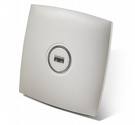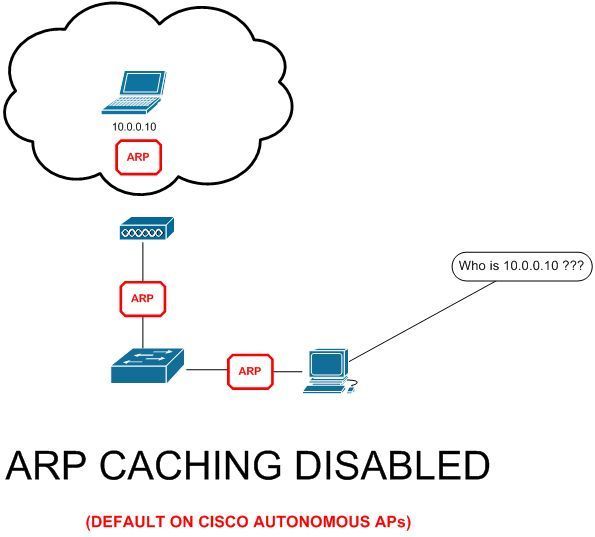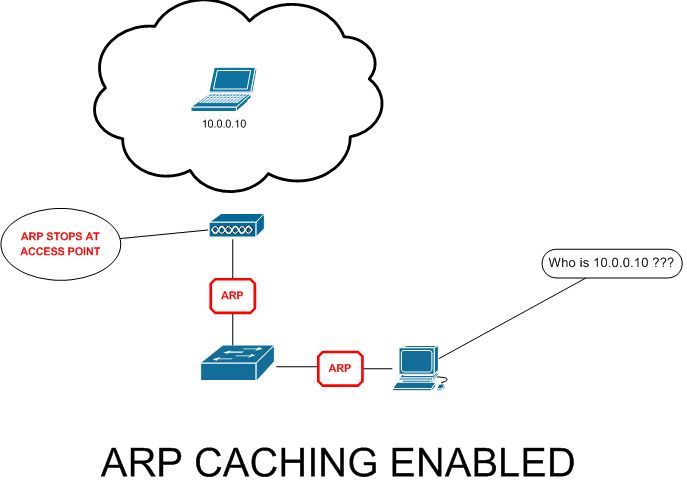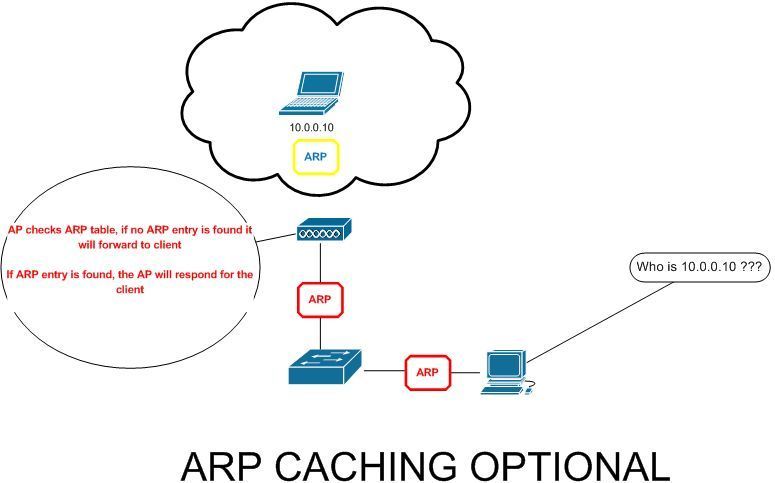A great post from Aaron Leonard (Cisco TAC)
These are debugs that you can collect while logged into the IOS CLI.
Basic setup
If you see a prompt that ends in a right angle bracket, like this:
ap>
it means that you are in unprivileged mode, so get privileged (which shows a # prompt):
ap>enable
Password:
ap#
(default username/password on APs is "Cisco".)
Configure NTP, timestamps, line timeout
ap#configure terminal
ap(config)#sntp server 1.2.3.4
ap(config)#service timestamp debug datetime msec
ap(config)#service timestamp log datetime msec
ap(config)#logging rate-limit 500
ap(config)#no logging console
[1]
ap(config)#line con 0
ap(config-line)#no exec-timeout
ap(config-line)#line vty 0 4
ap(config-line)#no exec-timeout
ap(config)#exit
ap#write (if you wan to to save the configuration changes to NVRAM)
#
[1] if you're going to generate debug messages at an extremely high rate, should be sure to turn off console logging, otherwise the AP will hang. (If your access is via the console, then of course you would need some other way to see the debugs then - e.g.
write them to a logging buffer, or to an external syslog server
. Or
increase the console port speed to 115200
.)
Collecting debugs from telnet or ssh session
Telnet/ssh into the AP, then enter the command "terminal monitor". The debug messages will be written to your terminal window. To save the messages, configure your terminal emulator accordingly.
Collecting debugs from a console session
Some development special debug output will be written only to the console. So in such a case, you must connect a serial cable to the AP's console port and access this cable via a terminal emulator program (e.g. Windows Hyperterminal talking to a PC COM port.) The default console port speed is 9600 bps which is too slow to collect a large volume of debugs - so increase the speed to 115200 bps, its maximum:
ap#configure terminal
ap(config)#logging console
ap(config)#line con 0
ap(config-line)#no exec-timeout
ap(config-file)#speed 115200
at this point, the terminal emulator program on the serial line will no longer be able to communicate with the console port, till you reset its speed to 115200 bps to match.
Radio names
The radios are usually called Dot11Radio0 (2.4GHz) and Dot11Radio1 (5GHz.)
ajax#show ip int brief
Interface IP-Address OK? Method Status Protocol
BVI1 10.0.47.21 YES DHCP up up
Dot11Radio0 unassigned YES unset up up
Dot11Radio1 unassigned YES unset administratively down down
FastEthernet0 unassigned YES other up up
You can abbreviate them to do0 and do1:
ajax#show controller do0
[...]
Radio AIR-AP1131G, Base Address 0012.44b3.e000, BBlock version 0.00, Software version 6.20.6
[...]
Configured Frequency: 2442 MHz Channel 7
Basic show commands
radio information
ajax#show interface dot11radio0
ajax#show controller dot11radio0
client information
ajax#show dot11 associations
ajax#show dot11 associations all
AP information
ajax#show config <= configuration (from NVRAM)
ajax#show run <= configuration (in memory)
ajax#show version <= model, version info
ajax#show tech <= everything - do "term length 0" first
Other basic commands
ajax#clear dot11 client 0011.2233.4455 <= deauthenticate a client
ajax#clear int dot11radio0 <= reset a radio
ajax#reload <= reboot the AP
Basic debug commands
radio debugs
ajax#no debug dot11 dot11radio0 print printf <= sometimes necessary to get radio debugs to log correctly
ajax#debug dot11 dot11radio0 trace print ? <= show list of flags
-- example:
-- debug dot11 dot11radio0 trace print mgmt keys <= mgmt frames & keying
dot1x/RADIUS debugs
ajax#debug dot11 aaa authenticator state-machine
ajax#debug dot11 aaa authenticator txdata
ajax#debug dot11 aaa authenticator rxdata
ajax#debug radius
Example debug output
This example uses all of the above listed debugs. This shows a client being deauthed, then successfully associating in LEAP with WPA2/AES. Note that the messages aren't all logged in order, i.e. the 802.11 association response sent by the AP is logged after the EAP ID-Request message is logged.
ajax#clear dot11 client 0040.96b4.7e8f
ajax#
Dec 5 23:14:58.537: %DOT11-6-DISASSOC: Interface Dot11Radio0, Deauthenticating Station 0040.96b4.7e8f Reason: Previous authentication no longer valid
Dec 5 23:14:58.619: 2149F234 t 1 0 - C040 13A B47E8F B3E000 B3E000 8250 deauth l 2
reason 2
Dec 5 23:14:58.623: 214A02B6-0 0040.96b4.7e8f- delete session key
Dec 5 23:15:02.184: 218059FB r 1 75/ 13- B000 130 B3E000 B47E8F B3E000 0290 auth l 6
algorithm 128
sequence 1
status 0
Dec 5 23:15:02.185: 21805E40 t 1 0 - B000 13A B47E8F B3E000 B3E000 84B0 auth l 6
algorithm 128
sequence 2
status 0
Dec 5 23:15:02.186: 218064A6 r 1 76/ 12- 0000 130 B3E000 B47E8F B3E000 02A0 assreq l 141
cap 431 infra privacy shorthdr
listen interval 10
ssid LEaP
rates 2 4 B C 12 16 18 24
extrates 30 48 60 6C
rsn1 mcst aes ucst aes keymgmt wpa2 cap 2800
221 - 0 50 F2 2 0 1 0
aironet AARON-GW-XP load 0 clients 0 hops 0 device 87-0
refresh 10 CW 0-0 flags 18 distance 0
IP 10.0.47.206 0
221 - 0 40 96 1 1 0
ccxver 5
221 - 0 40 96 14 7
Dec 5 23:15:02.188: dot11_auth_dot1x_send_id_req_to_client: Sending identity request to 0040.96b4.7e8f
Dec 5 23:15:02.189: EAPOL pak dump tx
Dec 5 23:15:02.189: EAPOL Version: 0x1 type: 0x0 length: 0x0028
Dec 5 23:15:02.189: EAP code: 0x1 id: 0x1 length: 0x0028 type: 0x1
01806BC0: 01000028 01010028 ...(...(
01806BD0: 01006E65 74776F72 6B69643D 4C456150 ..networkid=LEaP
01806BE0: 2C6E6173 69643D61 6A61782C 706F7274 ,nasid=ajax,port
01806BF0: 69643D30 id=0
Dec 5 23:15:02.190: dot11_auth_dot1x_send_id_req_to_client: Client 0040.96b4.7e8f timer started for 30 seconds
Dec 5 23:15:02.190: 21806A65-0 0040.96b4.7e8f- session key type 200 len 16, idx: 1, E2164DEDE9F1AA1D
Dec 5 23:15:02.191: 21807239 t 1 0 - 1000 13A B47E8F B3E000 B3E000 84C0 assrsp l 113
cap 431 infra privacy shorthdr
status 0
aid C001
rates 82 84 8B C 12 96 18 24
extrates 30 48 60 6C
aironet ajax load 0 clients 0 hops 0 device 89-2700
refresh 10 CW 15-1023 flags 1 distance 0
IP 10.0.47.21 1
ccxver 5
221 - 0 40 96 B 9
221 - 0 40 96 14 1
221 - 0 50 F2 2 1 1 8C 0 3 A4 0 0 27 A4 0 0 42 43 BC 0 62 32 66 0
Dec 5 23:15:02.192: 218076D6 t 1 0 - 8802 13A B47E8F B3E000 B3E000 C730 q7 l54
EAP id 1 req ident 0 "networkid=LEaP,nasid=ajax,portid=0"
Dec 5 23:15:02.205: 2180ACD3 r 1 75/ 13- 0801 130 B3E000 B47E8F B3E000 02B0 l21
0100 0009 0201 0009 016C 6561 7000 0000 0000 0000 00
Dec 5 23:15:02.205: EAPOL pak dump rx
Dec 5 23:15:02.205: EAPOL Version: 0x1 type: 0x0 length: 0x0009
Dec 5 23:15:02.205: EAP code: 0x2 id: 0x1 length: 0x0009 type: 0x1
01803280: 01000009 02010009 016C6561 70 .........leap
Dec 5 23:15:02.206: dot11_auth_dot1x_run_rfsm: Executing Action(CLIENT_WAIT,CLIENT_REPLY) for 0040.96b4.7e8f
Dec 5 23:15:02.206: dot11_auth_dot1x_send_response_to_server: Sending client 0040.96b4.7e8f data to server
Dec 5 23:15:02.206: dot11_auth_dot1x_send_response_to_server: Started timer server_timeout 60 seconds
Dec 5 23:15:02.207: RADIUS/ENCODE(00000B86):Orig. component type = DOT11
Dec 5 23:15:02.207: RADIUS: AAA Unsupported Attr: ssid [265] 4
Dec 5 23:15:02.207: RADIUS: 4C 45 [LE]
Dec 5 23:15:02.207: RADIUS: AAA Unsupported Attr: interface [157] 4
Dec 5 23:15:02.208: RADIUS: 33 31 [31]
Dec 5 23:15:02.208: RADIUS(00000B86): Config NAS IP: 0.0.0.0
Dec 5 23:15:02.208: RADIUS/ENCODE(00000B86): acct_session_id: 2948
Dec 5 23:15:02.208: RADIUS(00000B86): sending
Dec 5 23:15:02.208: RADIUS/ENCODE: Best Local IP-Address 10.0.47.21 for Radius-Server 10.0.47.20
Dec 5 23:15:02.208: RADIUS(00000B86): Send Access-Request to 10.0.47.20:1812 id 1645/10, len 123
Dec 5 23:15:02.209: RADIUS: authenticator 4B A2 CB 82 2F BD 4A DA - E8 78 72 BA 6B A3 04 16
Dec 5 23:15:02.209: RADIUS: User-Name [1] 6 "leap"
Dec 5 23:15:02.209: RADIUS: Framed-MTU [12] 6 1400
Dec 5 23:15:02.209: RADIUS: Called-Station-Id [30] 16 "0012.44b3.e000"
Dec 5 23:15:02.209: RADIUS: Calling-Station-Id [31] 16 "0040.96b4.7e8f"
Dec 5 23:15:02.209: RADIUS: Service-Type [6] 6 Login [1]
Dec 5 23:15:02.209: RADIUS: Message-Authenticato[80] 18
Dec 5 23:15:02.209: RADIUS: C2 F3 BA 46 5D CC A7 56 6F 75 CD D5 CF 71 A1 F2 [???F]??Vou???q??]
Dec 5 23:15:02.210: RADIUS: EAP-Message [79] 11
Dec 5 23:15:02.210: RADIUS: 02 01 00 09 01 6C 65 61 70 [?????leap]
Dec 5 23:15:02.210: RADIUS: NAS-Port-Type [61] 6 802.11 wireless [19]
Dec 5 23:15:02.210: RADIUS: NAS-Port [5] 6 3196
Dec 5 23:15:02.210: RADIUS: NAS-Port-Id [87] 6 "3196"
Dec 5 23:15:02.210: RADIUS: NAS-IP-Address [4] 6 10.0.47.21
Dec 5 23:15:02.215: RADIUS: Received from id 1645/10 10.0.47.20:1812, Access-Challenge, len 116
Dec 5 23:15:02.216: RADIUS: authenticator 89 E3 9A 73 09 D3 BC C7 - F5 3B 33 C4 1F 0D 71 25
Dec 5 23:15:02.216: RADIUS: EAP-Message [79] 22
Dec 5 23:15:02.216: RADIUS: 01 02 00 14 11 01 00 08 C2 F9 E3 AE 90 E0 5E 4D [??????????????^M]
Dec 5 23:15:02.216: RADIUS: 6C 65 61 70 [leap]
Dec 5 23:15:02.216: RADIUS: Session-Timeout [27] 6 10
Dec 5 23:15:02.216: RADIUS: State [24] 50
Dec 5 23:15:02.217: RADIUS: C2 F9 E3 AE 90 E0 5E 4D 00 00 00 00 00 00 00 00 [??????^M????????]
Dec 5 23:15:02.217: RADIUS: 00 00 00 00 00 00 00 00 00 00 00 00 00 00 00 00 [????????????????]
Dec 5 23:15:02.217: RADIUS: 24 B7 93 97 FE D4 04 23 78 5C 05 87 75 00 17 6C [$??????#x\??u??l]
Dec 5 23:15:02.217: RADIUS: Message-Authenticato[80] 18
Dec 5 23:15:02.217: RADIUS: B6 9B A4 4B A5 A0 81 5B CC 75 58 42 A9 3F C1 C3 [???K???[?uXB????]
Dec 5 23:15:02.218: RADIUS(00000B86): Received from id 1645/10
Dec 5 23:15:02.218: RADIUS/DECODE: EAP-Message fragments, 20, total 20 bytes
Dec 5 23:15:02.219: dot11_auth_dot1x_run_rfsm: Executing Action(SERVER_WAIT,SERVER_REPLY) for 0040.96b4.7e8f
Dec 5 23:15:02.219: dot11_auth_dot1x_send_response_to_client: Forwarding server message to client 0040.96b4.7e8f
Dec 5 23:15:02.219: EAPOL pak dump tx
Dec 5 23:15:02.219: EAPOL Version: 0x1 type: 0x0 length: 0x0014
Dec 5 23:15:02.219: EAP code: 0x1 id: 0x2 length: 0x0014 type: 0x11
01800CB0: 01000014 01020014 ........
01800CC0: 11010008 C2F9E3AE 90E05E4D 6C656170 ....Byc..`^Mleap
01800CD0:
Dec 5 23:15:02.220: dot11_auth_dot1x_send_response_to_client: Started timer client_timeout 10 seconds
Dec 5 23:15:02.221: 2180EC54 t 1 0 - 8802 13A B47E8F B3E000 B3E000 C740 q7 l54
EAP id 2 req leap 0100 08C2 F9E3 AE90 E05E 4D6C 6561 70
Dec 5 23:15:02.224: EAPOL pak dump rx
Dec 5 23:15:02.224: EAPOL Version: 0x1 type: 0x0 length: 0x0024
Dec 5 23:15:02.224: EAP code: 0x2 id: 0x2 length: 0x0024 type: 0x11
01807E10: 01000024 02020024 11010018 75682898 ...$...$....uh(.
01807E20: 897FB670 FA732F1A 09B92150 B21EF0F2 ..6pzs/..9!P2.pr
01807E30: 044CDEE4 6C656170 .L^dleap
Dec 5 23:15:02.225: dot11_auth_dot1x_run_rfsm: Executing Action(CLIENT_WAIT,CLIENT_REPLY) for 0040.96b4.7e8f
Dec 5 23:15:02.225: dot11_auth_dot1x_send_response_to_server: Sending client 0040.96b4.7e8f data to server
Dec 5 23:15:02.225: dot11_auth_dot1x_send_response_to_server: Started timer server_timeout 60 seconds
Dec 5 23:15:02.226: RADIUS/ENCODE(00000B86):Orig. component type = DOT11
Dec 5 23:15:02.226: RADIUS: AAA Unsupported Attr: ssid [265] 4
Dec 5 23:15:02.226: RADIUS: 4C 45 [LE]
Dec 5 23:15:02.226: RADIUS: AAA Unsupported Attr: interface [157] 4
Dec 5 23:15:02.226: RADIUS: 33 31 [31]
Dec 5 23:15:02.226: RADIUS(00000B86): Config NAS IP: 0.0.0.0
Dec 5 23:15:02.227: RADIUS/ENCODE(00000B86): acct_session_id: 2948
Dec 5 23:15:02.227: RADIUS(00000B86): sending
Dec 5 23:15:02.227: RADIUS/ENCODE: Best Local IP-Address 10.0.47.21 for Radius-Server 10.0.47.20
Dec 5 23:15:02.227: RADIUS(00000B86): Send Access-Request to 10.0.47.20:1812 id 1645/11, len 200
Dec 5 23:15:02.227: RADIUS: authenticator A7 50 BD F4 AA 2D 8A F3 - 92 EF 86 B2 2F 31 89 B4
Dec 5 23:15:02.228: RADIUS: User-Name [1] 6 "leap"
Dec 5 23:15:02.228: RADIUS: Framed-MTU [12] 6 1400
Dec 5 23:15:02.228: RADIUS: Called-Station-Id [30] 16 "0012.44b3.e000"
Dec 5 23:15:02.228: RADIUS: Calling-Station-Id [31] 16 "0040.96b4.7e8f"
Dec 5 23:15:02.228: RADIUS: Service-Type [6] 6 Login [1]
Dec 5 23:15:02.228: RADIUS: Message-Authenticato[80] 18
Dec 5 23:15:02.228: RADIUS: BA FE 70 17 A6 67 2B B3 A5 78 35 EB 6D AE 5B 36 [??p??g+??x5?m?[6]
Dec 5 23:15:02.228: RADIUS: EAP-Message [79] 38
Dec 5 23:15:02.229: RADIUS: 02 02 00 24 11 01 00 18 75 68 28 98 89 7F B6 70 [???$????uh(????p]
Dec 5 23:15:02.229: RADIUS: FA 73 2F 1A 09 B9 21 50 B2 1E F0 F2 04 4C DE E4 [?s/???!P?????L??]
Dec 5 23:15:02.229: RADIUS: 6C 65 61 70 [leap]
Dec 5 23:15:02.229: RADIUS: NAS-Port-Type [61] 6 802.11 wireless [19]
Dec 5 23:15:02.229: RADIUS: NAS-Port [5] 6 3196
Dec 5 23:15:02.230: RADIUS: NAS-Port-Id [87] 6 "3196"
Dec 5 23:15:02.230: RADIUS: State [24] 50
Dec 5 23:15:02.230: RADIUS: C2 F9 E3 AE 90 E0 5E 4D 00 00 00 00 00 00 00 00 [??????^M????????]
Dec 5 23:15:02.230: RADIUS: 00 00 00 00 00 00 00 00 00 00 00 00 00 00 00 00 [????????????????]
Dec 5 23:15:02.230: RADIUS: 24 B7 93 97 FE D4 04 23 78 5C 05 87 75 00 17 6C [$??????#x\??u??l]
Dec 5 23:15:02.230: RADIUS: NAS-IP-Address [4] 6 10.0.47.21
Dec 5 23:15:02.231: 2180F622 r 1 76/ 13- 0801 130 B3E000 B47E8F B3E000 02C0 l48
0100 0024 0202 0024 1101 0018 7568 2898 897F B670 FA73 2F1A 09B9 2150
B21E F0F2 044C DEE4 6C65 6170 0000 0000 0000 0000
Dec 5 23:15:02.245: RADIUS: Received from id 1645/11 10.0.47.20:1812, Access-Challenge, len 94
Dec 5 23:15:02.245: RADIUS: authenticator FE 64 BD 35 49 E1 0C C4 - 71 F5 9E B1 DE CB 45 9D
Dec 5 23:15:02.246: RADIUS: EAP-Message [79] 6
Dec 5 23:15:02.246: RADIUS: 03 02 00 04 [????]
Dec 5 23:15:02.246: RADIUS: State [24] 50
Dec 5 23:15:02.246: RADIUS: C2 F9 E3 AE 90 E0 5E 4D 75 68 28 98 89 7F B6 70 [??????^Muh(????p]
Dec 5 23:15:02.246: RADIUS: FA 73 2F 1A 09 B9 21 50 B2 1E F0 F2 04 4C DE E4 [?s/???!P?????L??]
Dec 5 23:15:02.247: RADIUS: D4 2C 1C 1C 49 4D 60 80 BC BC AF FC 91 78 37 92 [?,??IM`??????x7?]
Dec 5 23:15:02.247: RADIUS: Message-Authenticato[80] 18
Dec 5 23:15:02.247: RADIUS: 6E 86 16 34 26 7B 27 89 53 32 0A 49 DE 4E 65 FC [n??4&{'?S2?I?Ne?]
Dec 5 23:15:02.247: RADIUS(00000B86): Received from id 1645/11
Dec 5 23:15:02.248: RADIUS/DECODE: EAP-Message fragments, 4, total 4 bytes
Dec 5 23:15:02.248: dot11_auth_dot1x_run_rfsm: Executing Action(SERVER_WAIT,SERVER_REPLY) for 0040.96b4.7e8f
Dec 5 23:15:02.248: dot11_auth_dot1x_send_response_to_client: Forwarding server message to client 0040.96b4.7e8f
Dec 5 23:15:02.248: EAPOL pak dump tx
Dec 5 23:15:02.248: EAPOL Version: 0x1 type: 0x0 length: 0x0004
Dec 5 23:15:02.248: EAP code: 0x3 id: 0x2 length: 0x0004
01808F20: 01000004 03020004 ........
Dec 5 23:15:02.249: dot11_auth_dot1x_send_response_to_client: Started timer client_timeout 30 seconds
Dec 5 23:15:02.250: 21815D4C t 1 0 - 8802 13A B47E8F B3E000 B3E000 C750 q7 l54
EAP id 2 success
Dec 5 23:15:02.255: EAPOL pak dump rx
Dec 5 23:15:02.255: EAPOL Version: 0x1 type: 0x0 length: 0x0014
Dec 5 23:15:02.255: EAP code: 0x1 id: 0x2 length: 0x0014 type: 0x11
01804390: 01000014 01020014 11010008 496A7925 ............Ijy%
018043A0: 08614014 6C656170 .a@.leap
Dec 5 23:15:02.256: dot11_auth_dot1x_run_rfsm: Executing Action(CLIENT_WAIT,CLIENT_REPLY) for 0040.96b4.7e8f
Dec 5 23:15:02.256: dot11_auth_dot1x_send_response_to_server: Sending client 0040.96b4.7e8f data to server
Dec 5 23:15:02.256: dot11_auth_dot1x_send_response_to_server: Started timer server_timeout 60 seconds
Dec 5 23:15:02.257: RADIUS/ENCODE(00000B86):Orig. component type = DOT11
Dec 5 23:15:02.257: RADIUS: AAA Unsupported Attr: ssid [265] 4
Dec 5 23:15:02.257: RADIUS: 4C 45 [LE]
Dec 5 23:15:02.257: RADIUS: AAA Unsupported Attr: interface [157] 4
Dec 5 23:15:02.257: RADIUS: 33 31 [31]
Dec 5 23:15:02.258: RADIUS(00000B86): Config NAS IP: 0.0.0.0
Dec 5 23:15:02.258: RADIUS/ENCODE(00000B86): acct_session_id: 2948
Dec 5 23:15:02.258: RADIUS(00000B86): sending
Dec 5 23:15:02.258: RADIUS/ENCODE: Best Local IP-Address 10.0.47.21 for Radius-Server 10.0.47.20
Dec 5 23:15:02.258: RADIUS(00000B86): Send Access-Request to 10.0.47.20:1812 id 1645/12, len 184
Dec 5 23:15:02.258: RADIUS: authenticator 31 78 B8 F6 26 E4 36 F1 - 88 DB 25 40 53 56 A4 B5
Dec 5 23:15:02.259: RADIUS: User-Name [1] 6 "leap"
Dec 5 23:15:02.259: RADIUS: Framed-MTU [12] 6 1400
Dec 5 23:15:02.259: RADIUS: Called-Station-Id [30] 16 "0012.44b3.e000"
Dec 5 23:15:02.259: RADIUS: Calling-Station-Id [31] 16 "0040.96b4.7e8f"
Dec 5 23:15:02.259: RADIUS: Service-Type [6] 6 Login [1]
Dec 5 23:15:02.259: RADIUS: Message-Authenticato[80] 18
Dec 5 23:15:02.259: RADIUS: 31 01 9A B3 64 AA 5B DB 6C 76 31 AA A2 CD 3B F6 [1???d?[?lv1???;?]
Dec 5 23:15:02.259: RADIUS: EAP-Message [79] 22
Dec 5 23:15:02.260: RADIUS: 01 02 00 14 11 01 00 08 49 6A 79 25 08 61 40 14 [????????Ijy??a@?]
Dec 5 23:15:02.260: RADIUS: 6C 65 61 70 [leap]
Dec 5 23:15:02.260: RADIUS: NAS-Port-Type [61] 6 802.11 wireless [19]
Dec 5 23:15:02.260: RADIUS: NAS-Port [5] 6 3196
Dec 5 23:15:02.260: RADIUS: NAS-Port-Id [87] 6 "3196"
Dec 5 23:15:02.260: RADIUS: State [24] 50
Dec 5 23:15:02.261: RADIUS: C2 F9 E3 AE 90 E0 5E 4D 75 68 28 98 89 7F B6 70 [??????^Muh(????p]
Dec 5 23:15:02.261: RADIUS: FA 73 2F 1A 09 B9 21 50 B2 1E F0 F2 04 4C DE E4 [?s/???!P?????L??]
Dec 5 23:15:02.261: RADIUS: D4 2C 1C 1C 49 4D 60 80 BC BC AF FC 91 78 37 92 [?,??IM`??????x7?]
Dec 5 23:15:02.261: RADIUS: NAS-IP-Address [4] 6 10.0.47.21
Dec 5 23:15:02.262: 21816FB9 r 1 /75 12- 0801 130 B3E000 B47E8F B3E000 02D0 l32
0100 0014 0102 0014 1101 0008 496A 7925 0861 4014 6C65 6170 0000 0000
0000 0000
Dec 5 23:15:02.278: RADIUS: Received from id 1645/12 10.0.47.20:1812, Access-Accept, len 216
Dec 5 23:15:02.278: RADIUS: authenticator 52 FD 9C 2F 96 3A B9 B1 - F5 C1 59 17 A7 A5 DD FD
Dec 5 23:15:02.278: RADIUS: EAP-Message [79] 38
Dec 5 23:15:02.278: RADIUS: 02 02 00 24 11 01 00 18 AC BD 25 1F 89 7B CB 6F [???$?????????{?o]
Dec 5 23:15:02.279: RADIUS: 42 08 3B 37 62 8D 0D C7 78 9F 11 E3 5C D9 5B F1 [B?;7b???x???\?[?]
Dec 5 23:15:02.279: RADIUS: 6C 65 61 70 [leap]
Dec 5 23:15:02.279: RADIUS: Vendor, Cisco [26] 59
Dec 5 23:15:02.279: RADIUS: Cisco AVpair [1] 53 "leap:session-key=?
p<k2}l;q`o)2AHP2K%GXD>G:"
Dec 5 23:15:02.279: RADIUS: Vendor, Cisco [26] 31
Dec 5 23:15:02.279: RADIUS: Cisco AVpair [1] 25 "auth-algo-type=eap-leap"
Dec 5 23:15:02.279: RADIUS: State [24] 50
Dec 5 23:15:02.280: RADIUS: C2 F9 E3 AE 90 E0 5E 4D 75 68 28 98 89 7F B6 70 [??????^Muh(????p]
Dec 5 23:15:02.280: RADIUS: FA 73 2F 1A 09 B9 21 50 B2 1E F0 F2 04 4C DE E4 [?s/???!P?????L??]
Dec 5 23:15:02.280: RADIUS: D4 2C 1C 1C 49 4D 60 80 BC BC AF FC 91 78 37 92 [?,??IM`??????x7?]
Dec 5 23:15:02.280: RADIUS: Message-Authenticato[80] 18
Dec 5 23:15:02.280: RADIUS: A4 B6 3E 73 9D C0 5E 01 EB 1F 6A 57 D7 44 4C DF [??>s??^???jW?DL?]
Dec 5 23:15:02.281: RADIUS(00000B86): Received from id 1645/12
Dec 5 23:15:02.281: RADIUS/DECODE: EAP-Message fragments, 36, total 36 bytes
Dec 5 23:15:02.281: found leap session key
Dec 5 23:15:02.282: dot11_auth_dot1x_run_rfsm: Executing Action(SERVER_WAIT,SERVER_PASS) for 0040.96b4.7e8f
Dec 5 23:15:02.282: dot11_auth_dot1x_send_response_to_client: Forwarding server message to client 0040.96b4.7e8f
Dec 5 23:15:02.282: EAPOL pak dump tx
Dec 5 23:15:02.282: EAPOL Version: 0x1 type: 0x0 length: 0x0024
Dec 5 23:15:02.282: EAP code: 0x2 id: 0x2 length: 0x0024 type: 0x11
01804AE0: 01000024 02020024 11010018 ACBD251F ...$...$....,=%.
01804AF0: 897BCB6F 42083B37 628D0DC7 789F11E3 .{KoB.;7b..Gx..c
01804B00: 5CD95BF1 6C656170 \Y[qleap
Dec 5 23:15:02.283: dot11_auth_dot1x_send_response_to_client: Started timer client_timeout 30 seconds
Dec 5 23:15:02.284: 2181E306 t 1 0 - 8802 13A B47E8F B3E000 B3E000 C760 q7 l54
EAP id 2 resp leap 0100 18AC BD25 1F89 7BCB 6F42 083B 3762 8D0D C778 9F11
E35C D95B F16C 6561 70
Dec 5 23:15:02.286: 2181EA22 t 1 0 - 8802 13A B47E8F B3E000 B3E000 C770 q7 l129
EAPOL2 EAPOL key desc 02 008A 0010 0000 0000 0000 0001 5AD9 47C1 D022
5AE4 6C06 F77E AFD2 B48A D7CD 4D05 1510 DF8C F732 7D69 E62D A592 0000 0000
Dec 5 23:15:02.298: 21821818 r 1 /76 14- 0801 130 B3E000 B47E8F B3E000 02E0 l161
0103 0095 0201 0A00 0000 0000 0000 0000 01B1 3B6A A511 28C1 8CD6 A90B
8797 8C2F F115 1D9A 95C1 9BE1 C07E E9A8 9AA7 86C2 B500 0000 0000 0000 0000
Dec 5 23:15:02.302: 218227E8 t 1 0 - 8802 13A B47E8F B3E000 B3E000 C780 q7 l179
EAPOL2 EAPOL key desc 02 13CA 0010 0000 0000 0000 0002 5AD9 47C1 D022
5AE4 6C06 F77E AFD2 B48A D7CD 4D05 1510 DF8C F732 7D69 E62D A592 0000 0000
Dec 5 23:15:02.312: 21824F9A r 1 /76 15- 0801 130 B3E000 B47E8F B3E000 02F0 l107
0103 005F 0203 0A00 0000 0000 0000 0000 0200 0000 0000 0000 0000 0000
0000 0000 0000 0000 0000 0000 0000 0000 0000 0000 0000 0000 0000 0000 0000
Dec 5 23:15:02.313: %DOT11-6-ASSOC: Interface Dot11Radio0, Station AARON-GW-XP 0040.96b4.7e8f Associated KEY_MGMT[WPAv2]
Dec 5 23:15:02.314: 218252AE-0 0040.96b4.7e8f- session key type 200 len 16, idx: 0, B0DC14798C4898C6
More info
Quick Start Guide Cisco Aironet 1240AG Series Access Point
Configuration Guide
AP Command Reference
 Tuesday, January 29, 2013 at 11:18AM
Tuesday, January 29, 2013 at 11:18AM  George |
George |  Post a Comment |
Post a Comment | 


















